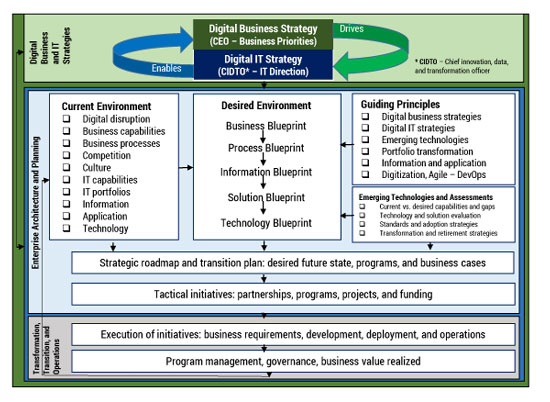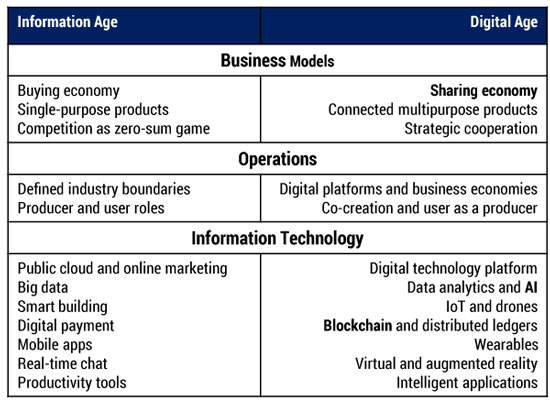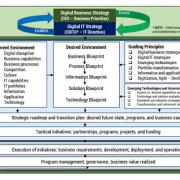The last 10 years of IT have been about changing the way people work. The next 10 years of IT will be about transforming your business.
— Aaron Levie, CEO of Box
Digital business and IT transformation is a very complicated undertaking. The starting point can vary, but in general it involves adoption of disruptive technologies and emerging business models, which in turn demands changes to organizational structure and business capabilities and processes. Transformation requires delicate, timely, and successful execution and management of changes being made to all aspects of a company, including business models, operations, and underlying IT, while optimizing use of resources and delivering innovative business capabilities. Having participated in and led multiple digital business and IT transformation initiatives, we believe that having a successful, well-connected, and respected enterprise architecture (EA) group with experienced enterprise architects is critically important in an organization’s effort to become a successful digital business. EA provides an approach for understanding and managing the complexity of digital transformation. As shown in Figure 1, EA plays a central role in enabling the transformation of a current business (or a startup, or a new line of business) into a digital business, while considering and supporting overall strategic digital business and IT strategy. Now let’s review the key components of digital business and IT transformation.

Digital Business and IT Strategies
Silicon Valley is coming, and if banks don’t up their game, then tech companies will take over the industry’s business. There are hundreds of startups with a lot of brains and money working on various alternatives to traditional banking.
— Jamie Dimon, CEO, JPMorgan Chase
Executives like Dimon are taking the risks associated with digital disruption seriously and not only confronting them directly, but taking advantage of the opportunities these disruptions present. Digital leaders continuously stay ahead of the curve in terms of new technologies and business models, invest heavily in developing optimized innovative solutions, and disrupt their own industries (or at times create brand-new ones) in order to remain industry pioneers and leaders. As seen in Figure 1, digital disruption, competition, and emerging trends are driving overall digital business strategies, which then drive digital IT strategies. Effective digital IT strategies and successful execution of long- and short-term plans enable organizations to realize the goals of digital business strategies and provide guidance to enterprise architecture. Consider some digital pioneers that have disrupted their own industry or created one that did not previously exist:
-
Netflix disrupted the overall video/game rental industry first by providing unlimited DVDs by mail and then by offering video streaming. The company has continued to disrupt the entertainment industry by becoming a producer of TV programs, with 90+ million subscribers. Within a decade of its existence, Netflix forced previous industry leader Blockbuster into bankruptcy.
-
Amazon, a pure digital company, disrupted the retail market, resulting in the closing of many electronics store chains and malls while increasing its customers’ loyalty. By leveraging its cost-effective and time-sensitive supply chain and fulfillment capabilities, Amazon continues to disrupt many other industries, such as groceries (with the acquisition of Whole Foods) and cloud services (having become the leading IaaS/PaaS/SaaS provider, with over 140+ services). Within 11 years, Amazon Web Services has become the number one cloud provider, moving way ahead of such firms as Google, Microsoft, and IBM.
-
John Deere is transforming itself from a company that sells and services big equipment to a company that helps farmers find more efficient ways to grow crops by utilizing new technologies like IoT, drones, and data-centric capabilities.
Digital disruption is becoming an essential part of the normal business cycle. To survive and thrive in this era, businesses need to fully grasp the leading new technologies; the shifting business, operational, and IT paradigms; and the implications of both for business — while proactively planning for disruptions caused by it all. Without proper planning for these disruptions, there is a high risk of becoming irrelevant in a short period, as businesses may not be able to compete successfully in dynamic markets. In today’s fast-moving environment, strategic, practical, and innovative partnerships between business and technology executives play a critical role in helping businesses respond to these forces of change.
As depicted in Figure 2, a paradigm shift is taking place across business models, supporting operations, and underlying information technologies. Leveraging any one of these by itself is quite disruptive and challenging, but when combined together, they represent a very complex undertaking with associated risks and awards. When it comes to emerging business models or technologies, we need to understand where they come from; how they will fit, benefit, and/or pose risk to the business; and where they are going. Each one of these elements could potentially have social, ethical, legal, financial, or governance implications, and these need to be addressed as well. Before we leverage new business models or technologies in the development of business solutions, we need to comprehend them holistically. Enterprise architecture and architects play a vital part in managing this complexity while delivering promised business value. Let us briefly look at three of these emerging trends and technologies.

Sharing Economy
The sharing economy allows individuals or businesses to use a service or rent an asset (with or without value-added services owned and provided by someone else), most probably using a digital platform. Such an economy allowed companies like Uber and Lyft to become leading providers of taxicab services without procuring any vehicles. Similarly, Airbnb has become one of the leading hospitality companies, with the largest number of available rooms and properties, without acquiring any properties itself. Instead these companies have provided an efficient digital platform for consumers and providers to conduct seamless transactions.
The sharing economy model is most likely to be used when the price of a particular asset or service is high and the asset is not fully utilized all the time. One thing to fully understand and plan for is possible legal liability and/or security issues.
Artificial Intelligence
AI makes us think of self-driving cars, drones delivering our holiday packages, and computers defeating humans at board games. Perhaps we might even envision Skynet from the Terminator movies running amok. Some pundits are talking about a massive shift in our society as AI, combined with robotics and automation, threatens to replace large numbers of people in the workforce within the coming decades. Should the use of AI, robotics, and automation come with some sort of tax or a policy to provide a minimum support structure for people replaced by them? While AI offers great potential and is being pursued by many leading businesses, it poses some potential risks as well. Would-be adopters will need to consider these benefits and risks carefully and strike a balance between them.
Blockchain
Over a short period of time, blockchain has gone from being a small presence (Bitcoin) to one of the most talked about technological innovations. As Harvard Business School (HBS) Professor Marco Iansiti and Cutter Fellow and HBS Professor Karim R. Lakhani observe:
The technology at the heart of Bitcoin and other virtual currencies, blockchain is an open, distributed ledger that can record transactions between two parties efficiently and in a verifiable and permanent way. The ledger itself can also be programmed to trigger transactions automatically.... With blockchain, we can imagine a world in which contracts are embedded in digital code and stored in transparent, shared databases, where they are protected from deletion, tampering, and revision.
This could have extensive implications for the way contracts are written, financial transactions occur, and the healthcare industry operates.
Once a company has committed itself to an executable digital business and IT strategy, management must define and implement an operating model that allows for execution of that strategy. The operating model will incorporate considerations such as policies, processes, organization structures, and performance measures, with a focus on innovation, time sensitivity, and team dynamics to retain a competitive edge. Senior leadership needs to clearly articulate the strategy and the operating model to the people involved and encourage everyone to take responsibility for business success.
[For more from the authors on this topic, see “Leveraging EA for Digital Business and IT Transformation.”]




